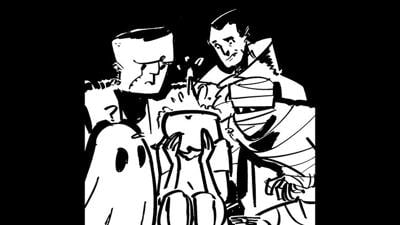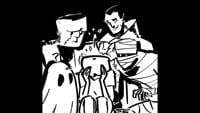The fading summer heat, cinnamon-spiced treats and the earthy smell of fallen leaves are the best parts of autumn.
But when it comes to Halloween, one of the most beloved holidays of the year? I say, “Boo,” humbug!
Halloween is more fun as an adult, but childhood memories from the spooky season are bittersweet. I was an anxious kid, even without the help from supermarket shelves stuffed with gnarled witch arms and motion-activated jumping spiders.
Even in my teenage years, which should have been the height of my bad decision-making, I refused to visit a haunted house. My friends were obsessed with the holiday and, despite my strong convictions, roped me into a haunted hayride.
If I could just sit and allow the scary things to happen around me without moving a muscle, surely it wouldn’t be so bad, I figured.
In retrospect, the operation was a little shady. The entrance was set up behind a ramshackle wooden fence in a gravel lot across the street from a gas station with little other signs of life.
Aside from our group of three, only one other rider was there, and she turned out to be a paid actress.
We hauled ourselves into the trailer, and, before the wheels even began to roll, a man in a werewolf mask crept out of the darkness, leapt up next to us and huffed in our faces. I huddled against my friend, faceplanted into her armpit and didn’t open my eyes until the ride ended and our actress friend was hauled away by a gang of crazed clowns.
Basically, I burned $15 on an immersive Halloween soundtrack experience.
That’s not to say I’m uninterested in the macabre, like most people. In an episode of “Speaking of Psychology,” a podcast produced by the American Psychological Association, behavioral scientist Coltan Scrivner said he believes most people have some degree of morbid curiosity.
He defined morbid curiosity as “a curiosity or an interest in things that are potentially dangerous.” This includes real events, like a murder we read about in the news, or fantastical situations, like a swamp monster stalking a campground.
Scrivner explained why people may be drawn to horror.
“There are some people who enjoy horror because they’re high in something called ‘sensation seeking.’ These are the same kind of people who go bungee jumping or skydiving or any number of things like that, that kind of give you an adrenaline boost.”
However, a study he conducted at a haunted attraction suggested that while some people enjoyed the thrill, many experienced genuine fear. When exploring fear, people feel like they learn something about themselves, Scrivner said, adding that engaging with activities that aim to scare, like watching a horror movie, can help people test the limits of fear and build self-confidence to face scary situations.
When asked if it’s possible to overdo it, Scrivner noted that people have good intuition about what’s “too much” for them.
“In some of the studies I’ve done,” he said, “we found that people will actually suppress their fear if they get too scared. So, they’ll cover their eyes, they’ll imagine that it’s not real, they’ll sort of avert their attention to something else or cover their ears. They’ll do things to kind of dull the sensations.”
Sound familiar? I wasn’t being a coward on that hayride; I was building confidence and practicing emotional regulation. At least, that’s what I tell myself.
I do indulge my morbid curiosity with the occasional horror movie, but they fall a little flat. I like closure, and horror tends to break the traditional storytelling mold. More often, I watch reactions, reviews or analyses of these films.
Many horror movies lean into tried-and-true tropes, such as ghosts, serial killers, monsters and more, making movies that delve into unconventional themes even more memorable. One example is “Midsommar,” a psychological horror film with a bright, summery visual aesthetic contrasted with gore.
Another is “Skinamarink,” filmed from the perspective of two children trapped in their house as the windows and doors blink out of existence. The shots are minimal and feature clips of toys, a staticky box television and whispered conversations between siblings.
Video games often take friendly looking characters and themes and twist them into something unsettling. A well-known example is “Five Nights at Freddy’s,” a game set inside a children’s entertainment center (a la Chuck-E-Cheese) where malevolent animatronic characters slowly hunt down the player.
Appearances can be so colorful and unassuming they fly under parents’ radar. While babysitting my two young nieces, my mom turned on a video featuring a character from the video game “Poppy’s Playtime.” I cracked up at her distress as she recounted a lanky, blue-furred cartoon with razor-sharp teeth lurching toward the screen.
My parents were protective of the media I consumed as a kid, but despite their well-intentioned efforts, I found plenty to fear. As I said, I was an anxious kid.
If you peek at my colleague Kevin Carbery’s trivia column this week, you’ll notice I’m not the only person with odd childhood fears.
One movie that disturbed me but didn’t bother most people was “Osmosis Jones,” a half animated, half live-action movie set mostly inside the body of Bill Murray’s character. While far from horrifying, I was very grossed out when learning about the body.
In elementary school, there was a traveling educational program that visited, featuring a big blow-up digestive system set up in the school gym. I listened to the introductory lesson inside a large human mouth while sitting on a chair shaped like a pearly-white molar. I got as far as the entrance to the esophagus before I ejected myself like a loogie.
Once again, a stellar display of knowing my limits.
So, maybe I need more of those light-hearted Halloween scares, which can teach us a thing or two.




